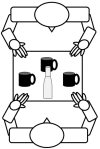Hand and Grasp Selection in a Preferential Reaching Task: The Effects of Object Location, Orientation, and Task Intention
- PMID: 27014165
- PMCID: PMC4793775
- DOI: 10.3389/fpsyg.2016.00360
Hand and Grasp Selection in a Preferential Reaching Task: The Effects of Object Location, Orientation, and Task Intention
Abstract
As numerous movement options are available in reaching and grasping, of particular interest are what factors influence an individual's choice of action. In the current study a preferential reaching task was used to assess the propensity for right handers to select their preferred hand and grasp a coffee mug by the handle in both independent and joint action object manipulation contexts. Mug location (right-space, midline, and left-space) and handle orientation (toward, away, to left, and to right of the participant) varied in four tasks that differed as a function of intention: (1) pick-up (unimanual, independent); (2) pick-up and pour (bimanual, independent); (3) pick-up and pass (unimanual, joint action); and (4) pick-up, pour and pass (bimanual, joint action). In line with previous reports, a right-hand preference for unimanual tasks was observed. Furthermore, extending existing literature to a preferential reaching task, role differentiation between the hands in bimanual tasks (i.e., preferred hand mobilizing, non-preferred hand stabilizing) was displayed. Finally, right-hand selection was greatest in right space, albeit lower in bimanual tasks compared to what is typically reported in unimanual tasks. Findings are attributed to the desire to maximize biomechanical efficiency in reaching. Grasp postures were also observed to reflect consideration of efficiency. More specifically, within independent object manipulation (pick-up; pick-up and pour) participants only grasped the mug by the handle when it afforded a comfortable posture. Furthermore, in joint action (pick-up and pass; pick-up, pour and pass), the confederate was only offered the handle if the intended action of the confederate was similar or required less effort than that of the participant. Together, findings from the current study add to our knowledge of hand and grasp selection in unimanual and bimanual object manipulation, within the context of both independent and joint action tasks.
Keywords: grasp selection; hand selection; object location; object orientation; preferential reaching; task intention.
Figures






Comment in
-
Commentary: Hand and Grasp Selection in a Preferential Reaching Task: The Effects of Object Location, Orientation, and Task Intention.Front Psychol. 2016 Jul 28;7:1129. doi: 10.3389/fpsyg.2016.01129. eCollection 2016. Front Psychol. 2016. PMID: 27515474 Free PMC article. No abstract available.
Similar articles
-
Hand selection in a preferential reaching task: The effects of object location, orientation, and task intention in preadolescent children.Brain Behav. 2018 Sep;8(9):e01025. doi: 10.1002/brb3.1025. Epub 2018 Aug 11. Brain Behav. 2018. PMID: 30099858 Free PMC article.
-
Hand preference for unimanual and bimanual tasks: Evidence from questionnaires and preferential reaching.Laterality. 2022 May;27(3):308-323. doi: 10.1080/1357650X.2021.1990313. Epub 2021 Oct 17. Laterality. 2022. PMID: 34658296
-
Hand preference across the lifespan: effects of end-goal, task nature, and object location.Front Psychol. 2015 Jan 20;5:1579. doi: 10.3389/fpsyg.2014.01579. eCollection 2014. Front Psychol. 2015. PMID: 25653633 Free PMC article.
-
Preferential Reaching and End-State Comfort: How Task Demands Influence Motor Planning.J Mot Behav. 2021;53(6):737-749. doi: 10.1080/00222895.2020.1858746. Epub 2020 Dec 17. J Mot Behav. 2021. PMID: 33331241
-
Manual (a)symmetries in grasp posture planning: a short review.Front Psychol. 2014 Dec 15;5:1480. doi: 10.3389/fpsyg.2014.01480. eCollection 2014. Front Psychol. 2014. PMID: 25566153 Free PMC article. Review.
Cited by
-
Relevant factors for arm choice in reaching movement: a scoping review.J Phys Ther Sci. 2022 Dec;34(12):804-812. doi: 10.1589/jpts.34.804. Epub 2022 Dec 1. J Phys Ther Sci. 2022. PMID: 36507080 Free PMC article.
-
To Pass or Not to Pass: Modeling the Movement and Affordance Dynamics of a Pick and Place Task.Front Psychol. 2017 Jun 28;8:1061. doi: 10.3389/fpsyg.2017.01061. eCollection 2017. Front Psychol. 2017. PMID: 28701975 Free PMC article.
-
Multiple Frames of Reference Are Used During the Selection and Planning of a Sequential Joint Action.Front Psychol. 2018 May 1;9:542. doi: 10.3389/fpsyg.2018.00542. eCollection 2018. Front Psychol. 2018. PMID: 29765341 Free PMC article.
-
Training in a cooperative bimanual skilled reaching task, the popcorn retrieval task, improves unimanual function after motor cortical infarcts in rats.Behav Brain Res. 2021 Jan 1;396:112900. doi: 10.1016/j.bbr.2020.112900. Epub 2020 Sep 14. Behav Brain Res. 2021. PMID: 32941880 Free PMC article.
-
Hand selection in a preferential reaching task: The effects of object location, orientation, and task intention in preadolescent children.Brain Behav. 2018 Sep;8(9):e01025. doi: 10.1002/brb3.1025. Epub 2018 Aug 11. Brain Behav. 2018. PMID: 30099858 Free PMC article.
References
-
- Becchio C., Sartori L., Castiello U. (2010). Toward you the social side of actions. Curr. Dir. Psychol. Sci. 19 183–188. 10.1177/0963721410370131 - DOI
-
- Bobbio T., Gabbard C., Caçola P. (2009). Interlimb coordination: an important facet of gross-motor ability. Early Childhood Res. Practice 11:n2.
LinkOut - more resources
Full Text Sources
Other Literature Sources
Research Materials

